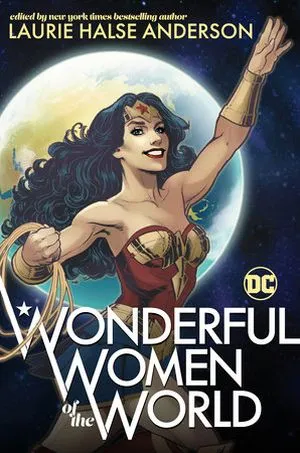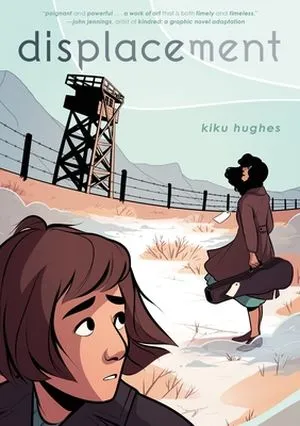
Graphic Novels and Graphic Nonfiction About Stuff You Should Care About
There are always people moaning on social media about how “woke” comics and graphic novels are getting; how the “SJWs” are “ruining” comics — and this is always said without a hint of irony. It’s almost as if the social justice themes of X-Men, Superman, Star Wars, Black Panther, and Captain America just sailed right over their heads. I mean, I don’t know how much more obvious it can be than superheroes literally punching Nazis, but okay.
While comics have always had social justice themes running through them, graphic novels and graphic nonfiction are also great ways to learn about social justice issues. Especially if you just can’t bring yourself to read a huge, dense book about a topic, a well-done comic can be an accessible way to learn about something new or start your reading journey through a new topic.
There are so many titles that I wanted to include in this post, but if I included all of the topics I wanted, along with all of the books, this would be an extremely long post. This is just a small sampling of what’s out there. No matter what the topic, if you’re looking for a comic about it, there’s probably one out there.
Feminism

Amazons, Abolitionists, and Activists: A Graphic History of Women’s Fight For Their Rights by Mikki Kendall
If you’re looking for a fun, informative read about the history of feminism, this is a fantastic start. This book looks at the history of women’s rights and stories of women throughout history, along with intersecting movements like LGBTQIA+ rights, reproductive rights, abolition, and more. Kendall’s book spans the world, looking at different laws and rules, and various historical time periods. It covers a huge span of time, so the depth of the stories is limited, but it’s a great primer to pique interest and spur further research.

Wonderful Women of the World Edited by Laurie Halse Anderson
Wonder Woman is amazing, and this book profiles 23 influential women who have made or who are making a difference, including Beyoncé, Judith Heumann, Keiko Agnea, Naomi Watanabe, and Ruth Bader Ginsburg. The art is beautiful, with illustrations by artists like Cat Staggs, Devaki Neogi, and Safiya Zerrogui.
LGBTQIA+ Issues

Be Gay, Do Comics by The Nib
Filled with more than 30 cartoonists, this anthology is a colorful, fun, and informative collection of queer comics. There’s queer history, satire about pronoun issues, decolonizing queerness in the Philippines, issues in global queer communities, the commodification of Pride, and much more. The diversity and breadth of the comics illustrate the scope of queer comics and voices.

Spellbound: A Graphic Memoir by Bishakh Som
Although the title says it’s a “graphic memoir,” Som describes it as a sort of hybrid diary comic and memoir. There are some fictionalizations and difference, so it’s not a strict memoir. Som is transgender, and she explores identity in this book, as well as the narratives we craft. It’s about family, friends, the creative journey, and discovering yourself.
History and Global Issues

Displacement by Kiku Hughes
In this YA graphic novel, Kiku is on vacation when all of a sudden, she finds herself back in time in the 1940s, in a Japanese American internment camp — but not just any camp; the one where her grandmother was forced into during WWII. These time travel displacements happen more and more until one day, she becomes stuck in the internment camp. This is her story of what she sees, and how the camp inmates managed to develop community, even in the worst of times, and survive.

Wake: The Hidden History of Women-Led Slave Revolts by Rebecca Hall and Hugo Martinez
This work of graphic nonfiction combines memoir with history to make a compelling, informative story brought to life by the amazing illustrations. During her research, Hall found out that far from taking a backseat, enslaved women were warriors who led revolts throughout history. Alongside her historical research, we also see how the history of slavery impacts her life and work today. It is a powerful book that shines a light on an often-ignored part of history.

Tiananmen 1989: Our Shattered Hopes by Lun Zhang, Adrien Gombeaud, Ameziane
Zhang, who was a young sociology teacher in 1989, writes his memories of the protests that ultimately resulted in a massacre in Tiananmen Square. Those of us who were alive back then remember that infamous picture of the lone person in front of a tank — but Zhang takes us deeper into the call for political reform and the movement behind the protests in this book.

Paying the Land by Joe Sacco
This book has been described as “comics journalism,” and that’s a great term for Sacco’s work. This title focuses on Indigenous North America and resource extraction. Sacco looks at the Dene, who live in the Mackenzie River Valley. They see the land as owning them, and it is a central part of their lives. But these Canadian NW Territories also contain oil and gas, and eventually mining, pipelines, and more intrude into the area, devastating the land and communities. Sacco explores the conflicts over this, how it negatively impacted the Dene and how the government stole their land, and puts all of this against a visual backdrop. He does not paint the Dene as a monolith, and his attention to detail and story is part of what makes this such a powerful book.
Mental Health

This is How I Disappear by Mirion Malle, Translated by Aleshia Jensen and Bronwyn Haslam
Clara’s not sure how much more she can take. She’s on deadline for a book and has writer’s block, she doesn’t feel supported by her friends, her therapist isn’t much of a help, and when she does seek comfort from her community, she still feels isolated. Clara struggles with depression, self-harm, and recovery from trauma, and Malle writes about this with honesty and care. Sprinkled throughout are examples of how social media can play a part in both harming and helping, and how it can even help heal.

The Way She Feels: My Life on the Borderline in Pictures and Pieces by Courtney Cook
In this graphic memoir, Cook writes (and draws) about what it’s like living with borderline personality disorder — but not just the hospitalizations and therapies, but also the things that comfort her, the things that scare her, and things that make life easier. Her honesty and realness are part of what makes this book so powerful, and her art is the perfect complement to her writing.
Current Events

Comics for Choice: Illustrated Abortion Stories, History, and Politics by Whit Taylor, Ã.K. Fox, Hazel Newlevant
This anthology focuses on abortion, and the stories in this collection come from over 60 artists and writers, with a diverse set of perspectives: trans voices, older voices, activists, lawyers, doctors, and more. There are personal stories, history primers, current political and legal struggles, and issues within reproductive justice. With the current political climate in many states hell-bent on gutting reproductive rights, this is more timely than ever.

Where We Live: Las Vegas Shooting Benefit Anthology by J.H. Williams III
After the Las Vegas mass shooting in 2017, this anthology was created. It has fictional stories alongside eye-witness stories of the shooting, and accounts about mental health, common sense gun control, gun violence, and more. Comics writers and artists like Brian Bendis, Alex Segura, Neil Gaiman, Gail Simone, and Kelly Sue DeConnick are contributors to this important collection. Things have not improved much since then, making this a collection worth revisiting.

Run: Book One by John Lewis, Andrew Aydin, L. Fury, Nate Powell
If you’ve read the trilogy March, this is the story of what happened afterward. It follows Lewis in the 1960s and beyond, with voter suppression, police brutality, and resistance to change and progress — all of which are still very prevalent today. It goes into the Watts riots, reactions to the Vietnam War, and the Student Nonviolent Coordinating Committee (SNCC), of which Lewis was a chairman. At the end, the book also has a list of people instrumental in the civil rights movement, for further reading and research.
For more graphic novels and comics about social justice issues, check out these comics about social justice, and these social justice superheroes.





